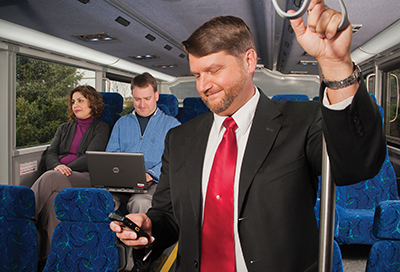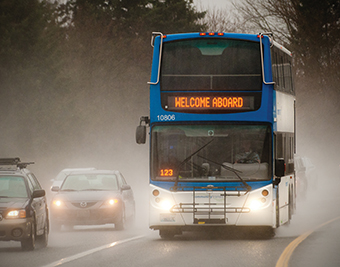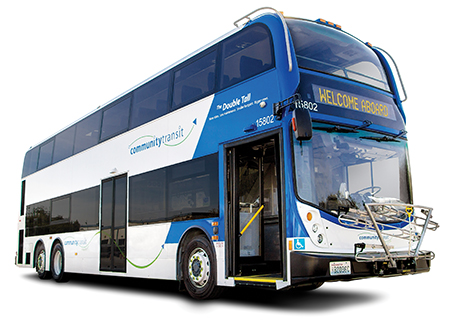
OFFICIAL BUSRide Field Test: The Enviro500
by Alexander Dennis Inc. brings a new dimension to transit in Seattle
By Richard Tackett

When the “Double Tall” buses – otherwise known as the Enviro500 by Alexander Dennis Inc. (ADI) – pull up to their earliest morning and afternoon stops, it’s surprising to see how many passengers come onboard. That’s because riders of Community Transit, based in Snohomish County, WA, want to make sure they get the “best” seats on these double-decker vehicles.
“The first thing riders rush to do is sit in the upper saloon, which is understandable,” says Martin Munguia, corporate communications manager at Community Transit. “We find that people try to catch the bus at its earliest stops in the mornings and afternoons, because they want second-level seats toward the front of the bus. Still, even if they’re seated further back, any view from the upper saloon is great.”

Trial runs
Community Transit, serving the Seattle and Puget Sound area, saw approximately 9.8 million passenger trips in 2014. It runs 25 local routes and 19 commuter routes over a service area of 1,305 square miles. Approximately 39,000 passengers use the service each day.
Initial interest in the Enviro500 came about because of an order by the Regional Transit Commission (RTC) of Southern Nevada. RTC saw the bus at the APTA EXPO in 2002, which happened to be in Las Vegas, and the then-general manager saw it as a fantastic opportunity to get high-capacity buses into the Las Vegas strip corridor. Along with improving vehicle capacity, he rightly predicted that the buses would “pull in” tourists and increase ridership.
“Community Transit had seen the buses being supplied to Las Vegas and they knew that the vehicles had worked well,” says Stephen Walsh, vice president at ADI. “Our first delivery to Las Vegas was in 2005. A lot of the initial sales of the double-decker were made through transit managers and CEOs that were somewhat innovative and entrepreneurial. Las Vegas wasn’t afraid of trying something new, and they helped ‘grandfather’ Community Transit with their experience.”

Joyce Olsen, then-CEO at Community Transit, was also innovative. At the suggestion of June DeVoll, a senior planning manager formerly with RTC, she requested that ADI bring the Enviro500 to Washington for a trial run. The trial lasted one month and Community Transit liked the results, but was still cautious. The agency requested that ADI lease out the bus for one to two years, so that the agency could run it through normal routes and gauge its acceptability with the rest of the fleet.
“We built it, they leased it, they renewed their lease for another year, and in the end they decided they very much liked what the bus was doing,” Walsh says.
“We surveyed customers about the buses, and of course we were also talking to our drivers and mechanics,” Munguia says. “During that leasing period, we received incredibly high marks from all involved. The customers loved the scenic views, so much so that they were excited to ride the bus. They’d pass up an articulated vehicle just to wait for a double-decker.
From an operations perspective, Munguia says the vehicle’s handling was a lot more like a 30-foot bus than a 40-foot bus because of its triple axel. Furthermore, riders and drivers loved that the bus handled much better in inclement weather than the articulated buses in Community Transit’s fleet.
“We provide service from downtown Seattle to Snohomish County, which is about 25-30 miles north of Seattle,” he says. “For those trips, our riders are getting on a bus in a park and ride and then sitting there for as long as 60 minutes on the ride to and from Seattle. We have a lot of 60-foot articulated buses, but they have their issues. When we get bad weather, we sometimes have to pull them off the road. Seattle is a very hilly city, and you don’t want to drive articulated buses on icy roads.”

At the end of the trial, agency planners found that the bus worked very well for their purposes. Discussions soon began with ADI. The agency found that RTC had received a waiver for Buy America compliance, but Community Transit decided early on that it needed to use federal money – and thus, wouldn’t seek a waiver.
Community Transit worked closely with ADI to manufacture a bus that would meet Buy America regulations. It took a bit of work, and ADI needed to contract with a plant in the U.S., but ADI met the specs of the contract and the first order for 23 buses was delivered in 2011. In 2015 another 22 Double Talls were delivered.
Today, Community Transit has 45 double-decker buses in service – making theirs the second largest fleet of double-deckers in the U.S.
The “Double Tall”
The Enviro500, or the “Double Tall” as it’s called in homage to Seattle’s coffee culture, has an overall height of 13.6 feet and length of 42 feet. It weighs 52,911 pounds and features a ceiling height of 5 feet, 7 inches. The Enviro500 uses less fuel than an articulated bus and also requires less maintenance thanks to the lack of a “joint” in the middle. It can seat up to 77 passengers with standing room for up to 20 more – a marked improvement over the 60-foot, 60-seat buses they replaced.
All seats have 3 inches more hip-to-knee room than standard, reading lights and individual air vents. Extra-large windows provide a panoramic view of the beautiful Puget Sound area.
The “Double Tall” moniker was an instant hit with local riders. Riders, who had been waiting excitedly since the leased bus was pulled from service, were ecstatic to board the brand new vehicles.
“It’s an interesting concept, as Seattle is known for its coffee,” Walsh says. “We welcome our customers naming the buses, because it separates the service and gives it more brand identity. It creates positive publicity for the agency.”

Working together
Obviously the introduction of so many double-decker buses warranted some changes at the agency – but Community Transit
